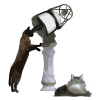google_alternate_color = "000000";
google_ad_width = 200;
google_ad_height = 90;
google_ad_format = "200x90_0ads_al_s";
google_ad_channel ="8110140219";
google_color_border = "000000";
google_color_bg = "FFFFFF";
google_color_link = "0066CC";
google_color_text = "000000";
google_color_url = "3333CC";
//-->
Issues of 2004
This page lists the home pages for this web site for the year 2006. These pages constitute
volume 1 of The Astrophysics Spectator.
- Issue 1.10, December 15, 2004.
The “Gravitational Physics”
path is inaugurated with pages that discuss the Keplerian orbit
of binary stars and planets. A page on the Kuiper Belt is added to
the “Solar Planetary System” path.
And a commentary on fame and the astrophysicist
is added to the site.
- Issue 1.9, December 8, 2004.
In issue 1.9 of The Astrophysics Spectator, the general properties of galaxies and
the properties of elliptical and spiral galaxies are described in four pages on the
new galaxy path. The commentary for this issue justifies the study of astrophysics
as a pursuit of generalists.
- Issue 1.8, November 24, 2004.
The topics of Jupiter and Saturn are taken up in issue 1.8
of The Astrophysics Spectator. Pages on Jupiter's Great Red Spot and magnetosphere
and on Saturn's rings are presented. The commentary argues that there is a place
for a great books education in science.
- Issue 1.7, November 17, 2004.
Cosmology is a topic that has a philosophical resonance. In this issue of
The Astrophysics Spectator our basic understanding of the cosmological
expansion of the galaxies is discussed. This topic raises the question of when
is it appropriate to invoke new physics? This question is discussed in this issue's
commentary.
- Issue 1.6, November 10, 2004.
This issue presents two pages on the primary methods used in astronomy to determine distance.
Within the Galaxy, the best method for determining the distance to a star is to measure
the star's parallax. The distance to a galaxy is measured using Cepheid variables,
type 1a supernovae, and the cosmological redshift. The commentary for this week
is on Pythagoras and the distance of modern astrophysics from this philosopher.
- Issue 1.5, November 3, 2004.
Gamma-ray bursts are discussed in issue 1.5. Pages are added on the basic characteristics of
the gamma-ray bursts and on the experiments designed to study them. A page discusses
the effects of special relativity on astronomical sources such as gamma-ray bursts. And a
commentary is included on the link between baseball and our knowledge of the world.
- Issue 1.4, October 27, 2004.
This issue introduces the Solar System Planet path. The first pages on this path discuss the
giant gaseous planets Jupiter and Saturn, and the Cassini satellite that is now orbiting
Saturn. The week's commentary is about reading as a child a book by the futurist
R. Buckminster Fuller.
- Issue 1.3, October 20, 2004.
The third issue continues the discussion gravitational waves with pages
that describe the cryogenic
resonant bar detectors and the results from the S2 data run
of the LIGO Michelson interferometers.
The commentary for the week asks whether Einstein's greatest blunder is being
repeated.
- Issue 1.2, October 13, 2004.
This issue
of The Astrophysics Spectator features a new path about gravitational waves. This path
introduces the physics of gravitational waves and discusses how scientists are trying to
detect them for the first time using a device called the Michelson
interferometer. The commentary of the week discusses how expectations for expensive experiments
are sometimes exaggerated.
- Issue 1.1, October 6, 2004.
The first issue
of The Astrophysics Spectator. This issue features the Stars trail
and eleven commentaries ranging from education to Dan Rather and the bloggers.


